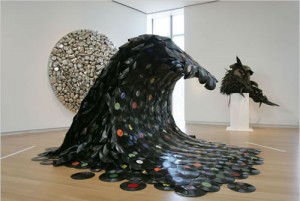Immediate Response
After finding the “Balloon Swan (Magenta)” I was struck by its unique form. The bright pink color drew me in, and I was struck by the reflective nature of the piece.
Objective Description
Jeff Koons, “Balloon Swan (Magenta)” consists of high chromium stainless steel molded in the shape of a balloon animal. There is a transparent color coating on top. The structure has a reflective surface and acts as a mirror for those walking past. Unlike a regular mirror, it distorts reality by changing both the size and color of the image being presented. “Balloon Swan (Magenta)” is almost 12 feet tall.
Technical Decisions
Koons used chromium stainless steal, an uncommon material to recreate a well known material, balloons. The scale of “Balloon Swan (Magenta)” creates importance and gives the object power. Ordinarily one would not have the same experience with a real balloon animal, especially one that is pink. Koons also created the same swan in five unique versions. Each one is a different color such as blue, violet, yellow and red.
The Work in the World
As I mentioned above, “Balloon Swan (Magenta)” is a direct reminder of a balloon animal given to children at birthday parties and the circus. They symbolize youth, playfulness and inferiority. Such toys do not last long and are usually forgotten about after a few days. “Balloon Swan (Magenta)” changes the definition balloon animals. “Balloon Swan (Magenta)” is a lasting sculpture which instills power, yet still manages to possess the child playfull nature.
The Story it Tells
Koons message behind “Balloon Swan (Magenta)” is the celebration of childhood. “Balloon Swan (Magenta)” is in the shape of a balloon animal given to children; however, “Balloon Swan (Magenta)” serves a completely different purpose and gives off a different effect. Because of its large size, “Balloon Swan (Magenta)” seems powerful, and because of its stainless steal material, it seems sturdy.





























































































































































































